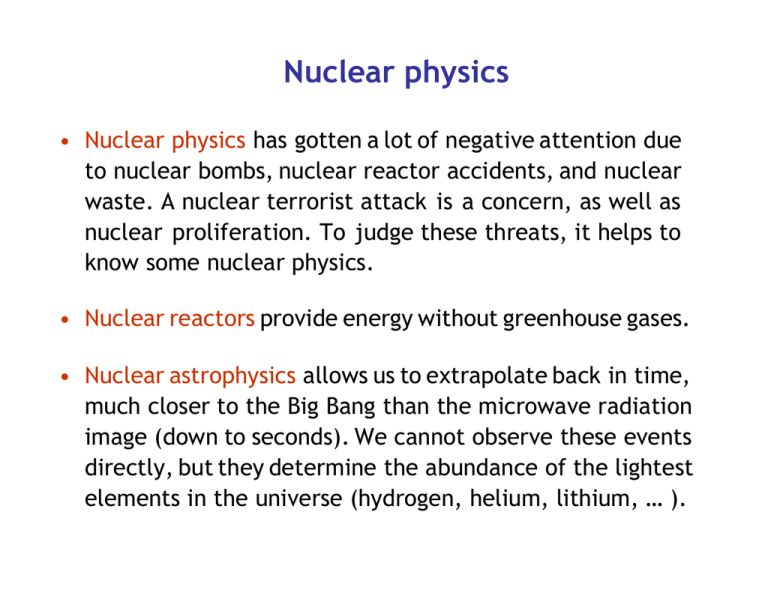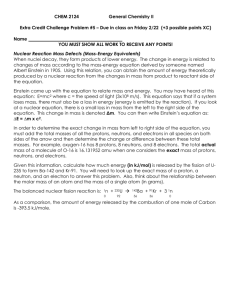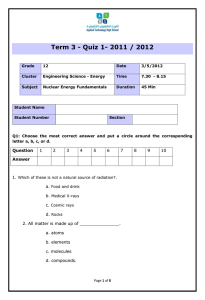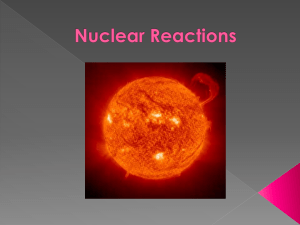Nuclear Physics: Nucleus, Forces, and Early Universe
advertisement

Nuclear physics • Nuclear physics has gotten a lot of negative attention due to nuclear bombs, nuclear reactor accidents, and nuclear waste. A nuclear terrorist attack is a concern, as well as nuclear proliferation. To judge these threats, it helps to know some nuclear physics. • Nuclear reactors provide energy without greenhouse gases. • Nuclear astrophysics allows us to extrapolate back in time, much closer to the Big Bang than the microwave radiation image (down to seconds). We cannot observe these events directly, but they determine the abundance of the lightest elements in the universe (hydrogen, helium, lithium, … ). The Nucleus Ch. 14.1,2 • A nucleus consists of: protons (p) + neutrons (n) = nucleons • Protons have positive charge. Neutrons have zero charge. Proton • Nucleons are 2000 times heavier than electrons. • A nucleus is 20 000 times smaller than an atom. • The mass of an atom is extremely concentrated in the tiny nucleus. Neutron The nuclear force • What holds the nucleus together? Electric force? Gravity? • Electric force is repulsive between protons • Gravitational attraction is much too weak. (1036 times weaker than the electric force) Nuclear versus electric force • In an atom, electrons are bound to the positive nucleus by the electric force. The binding energy in H is 13.6 eV. • The outer electrons involved in chemistry are typically bound by energies of 1-10 eV. • Protons in a nucleus are 5000 times closer to each other, with a 5000 times larger proton-proton repulsion energy. • An even larger energy must hold the nucleus together. • In fact, the nuclear force binds nucleons together with about 8 MeV per nucleon, which is a million times higher than chemical energies from burning fuel or explosives. What is this nuclear force ? • All forces arise from an exchange of particles. • The electric force arises from the exchange of photons. • The nuclear force is caused by the exchange of pions . • At a more fundamental level the nuclear force becomes the strong force, caused by the exchange of gluons . Electromagnetic vs. nuclear force Feynman diagrams = World lines of particles (Lect. 15, Slide 10) Space Electromagnetic force Nuclear force The fundamental strong force Ch. 17.3,5 • The strong force acts between the quarks inside the nucleons. • The strong force arises from the exchange of gluons (red arrows). • The gluons “glue” quarks into protons, neutrons, and pions. • Gluons also glue protons and neutrons together when they are exchanged between quarks in different protons/neutrons. u gluon u u u Strong force A look inside the nucleus • A nucleus consists of protons and neutrons. • Protons and neutrons consist of quarks. • Quarks cannot be split further. They represent fundamental particles, like electrons. • If one smashes quarks into each other, they do not disintegrate. Instead, new quarks are created. Visualizing a nucleus A nucleon made up of three quarks A large nucleus with many nucleons and quarks interacting via gluons. Colors indicate the color quantum number of quarks/gluons (Lect.35). Four fundamental forces The early universe Ch. 11.2 • Can we go back further in time than the microwave background image ? • Not directly , but nuclear physics helps us extrapolating back towards a period closer to the Big Bang, where the universe was very hot. The thermal energy ripped atoms , nuclei , and nucleons apart and created many pairs of particles and their antiparticles . Imagine a boiling broth of quarks and gluons. As the universe cools, the following happens: Time after the Big Bang s – ms: Quarks and gluons form nucleons + antinucleons. 1 second: Nucleons/antinucleons annihilate, leave nucleons. 3 seconds: Electrons/positrons annihilate, leaving electrons. 20 minutes : Protons and neutrons form nuclei. 400 000 years: Electrons and nuclei form atoms . Where did the antimatter go ? • The universe appears to be made of matter (protons, neutrons, electrons). Particle theory says that each particle has an antiparticle (antiproton, antineutron, positron, Lect. 33). Why don’t we see antiparticles? • We don’t know the full story, but there are a few concepts that explain part of it: 1) In its first seconds , the universe contained similar numbers of particles and antiparticles, with a slight excess of particles. All the antiparticles annihilated and the remaining particles formed our universe. 2) Particles and antiparticles are not treated equally by the weak interaction.




